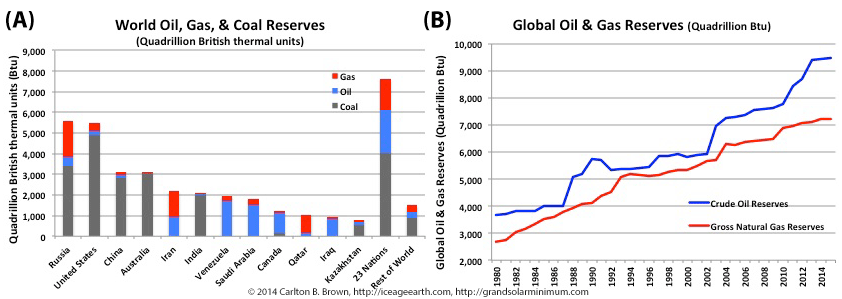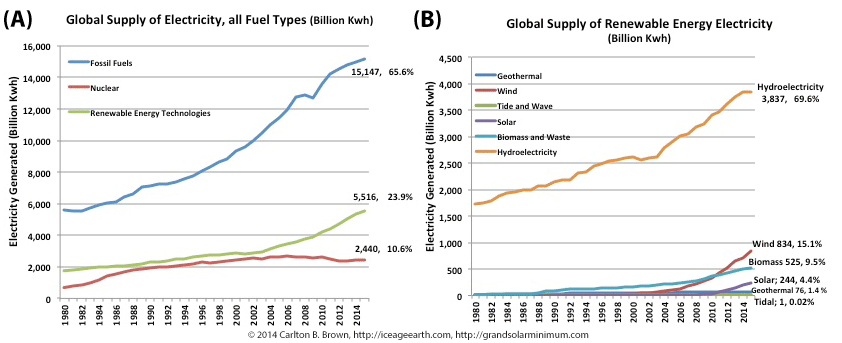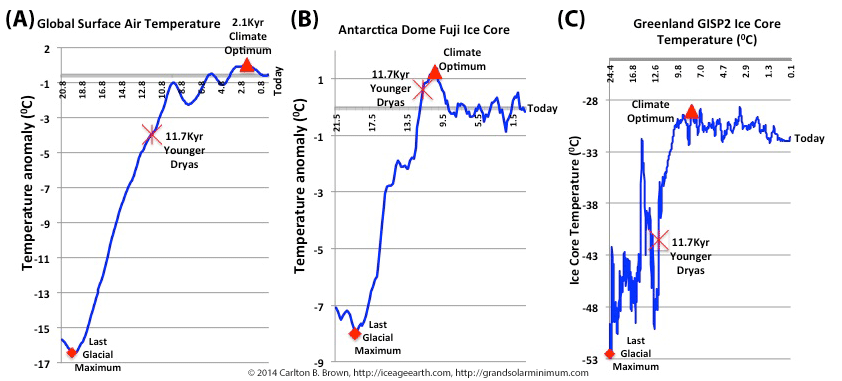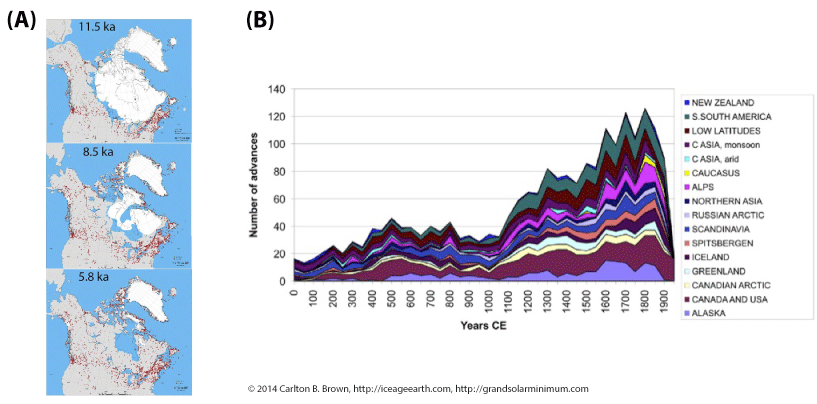A graphic of Greenland’s ice core climate reconstruction from 9080 BCE (after the Younger Dryas) to 1960 CE is positioned alongside a 20-year moving average of the Northern Hemisphere temperature anomaly (1870 to 2018; right hand diagram).[i] This depicts how the modern instrument era-derived Northern Hemisphere temperature data relates to Greenland’s ice core temperature data. This juxtaposition of different climate data was done to give an approximate bearing on today’s climate relative to the climate optimum.
Greenland’s ice temperature actually declined by 4.860C between the Holocene Climate Optimum in 5980 BCE (peak temperature) and 1700 CE, and then rose by 2.870C between 1700 CE and 1940 CE. The 2016 temperature peak is still 1.90C lower than at Greenland’s Holocene Climate Optimum 8,000 years ago.
By comparing today’s temperature only with that in 1880 we are being led to believe that a 1.020C rise in temperature since 1880 is the highest on record.[ii] However, when today’s temperature is compared with the Holocene Climate Optimum’s temperature 7,980 years ago, then that highest rise in temperature on record actually represents a decline of 1.90C. According to climate science experts who specialize in the Holocene Arctic climate, the Arctic temperatures was in general two to four degrees Celsius higher 8,000 to 5,000 years ago than it is today.[iii],[iv],[v]
The Arctic ice core data, like the Antarctic and global climate data, as well as the Northern Hemisphere insolation data (precession of the summer solstice),[vi],[vii],[viii],[ix] tells us emphatically that we have already entered an ice age (8,000 years ago). The Intergovernmental Panel on Climate Change’s anthropogenic global warming story started in 1880, and was “grafted on” to a trough-to-peak warming phase that started in 1700, and long before the anthropogenic influence became significant.
Click on this page and download a free copy of my book “Revolution: Ice Age Re-Entry,” and read more about this topic in Chapter 4.
[i] Data: (1) B.M. Vinther et al., 2009, “Holocene thinning of the Greenland ice sheet.” Nature, Vol. 461, pp. 385-388, 17 September 2009. National Centers for Environmental Information, NESDIS, NOAA, U.S. Department of Commerce. Greenland Ice Sheet Holocene d18O, Temperature, and Surface Elevation. doi:10.1038/nature08355. https://www.ncdc.noaa.gov/paleo-search/study/11148. Downloaded 05/05/2018. (2) HadCRUT4 near surface temperature data set for the Northern Hemisphere. http://www.metoffice.gov.uk/hadobs/hadcrut4/data/current/download.html. Downloaded 25 July 2018.
[ii] Global mean surface temperature data, commonly referred to as HadCRUT4. https://www.metoffice.gov.uk/hadobs/hadcrut4/data/current/download.html. [Exposé: Look at the bottom left hand or first column for the current year-to-date temperature. Subtract that from the 2016 total to see the magnitude of the fall. Global Data: https://bit.ly/2nCgctz. Northern Hemisphere Data: https://bit.ly/2MRt75G, Southern Hemisphere Data: https://bit.ly/2nBfYTA. Tropics Data: https://bit.ly/2nFXJMM. [last downloaded 25/07/2018].
[iii] Nicolaj K. Larsen et al., “The response of the southern Greenland ice sheet to the Holocene thermal maximum.” Geology ; 43 (4): 291–294. doi: https://doi.org/10.1130/G36476.1.
[iv] D.S. Kaufman et al., “Holocene thermal maximum in the western Arctic (0–1800W).” Quaternary Science Reviews 23 (2004) 529–560.
[v] J.P. Briner et al., “Holocene climate change in Arctic Canada and Greenland.” Quaternary Science Reviews (2016), http://dx.doi.org/10.1016/j.quascirev.2016.02.010.
[vi] H. Wanner et al., “Structure and origin of Holocene cold events.” Quaternary Science Reviews (2011), doi:10.1016/j.quascirev.2011.07.010. [Comment: See Figure 5a, page 9, depicting the steady decline in Northern Hemisphere summer solar insolation at north 15 and 65 degree latitudes, and indicating that insolation has declined by 40 W/m2. This is based on the landmark research by Berger, 1978 (André Berger, Long-Term Variations of Daily Insolation and Quaternary Climatic Changes. 1978. Journal of the Atmospheric Sciences 35(12):2362-2367. DOI: 10.1175/1520-0469(1978)035<2362:LTVODI>2.0.CO;2).].
[vii] D.S. Kaufman et al., “Holocene thermal maximum in the western Arctic (0–180°W).” Quaternary Science Reviews, Volume 23, Issues 5–6, 2004, 529-560. https://doi.org/10.1016/j.quascirev.2003.09.007. [Comment: See the abstract. We are told that the precession-driven summer insolation anomaly peaked 12,000-10,000 years ago. See also Figure 9a which depicts the 65°N insolation anomaly at different times of the year, indicating an approximate 50 Wm-2 decline in summer solstice insolation from its peak 12,000-10,000 years ago.].
[viii] Darrell Kaufman et al., “Recent Warming Reverses Long-Term Arctic Cooling.” September 2009. Science 325(5945):1236-1239. DOI: 10.1126/science.1173983. [Comment: This publication details the Arctic cooling that has been in progress for the last 2,000 years until this recent global warming phase. This millennial-scale cooling trend correlates (r = +0.87 with a R-squared 0.76, see Figure 4.) with a reduction in precession of the solstice driven summer insolation (6 W m−2 insolation at 65°N) for the last 2,000 years. See Figure 3F. The publication indicates a temperature decline of 0.22° ± 0.06°C per 1000 years, which tracks the slow decline in orbitally driven summer insolation at high northern latitudes.].
[ix] I. Borzenkova et al., 2015. Climate Change During the Holocene (Past 12,000 Years). In: The BACC II Author Team (eds) Second Assessment of Climate Change for the Baltic Sea Basin. Regional Climate Studies. Springer. https://link.springer.com/content/pdf/10.1007%2F978-3-319-16006-1.pdf







Recent Comments